Approach When to Use Where to Use When introducing new Constructivist concepts through real-life experiences and exploration Discovery tables, outdoors, learning centers When connecting multiple subject areas in one activity or theme-based project Morning routines, project-based corners For whole-week or monthlong thematic instruction (e.g., “My Family”, “Colors”) Circle time, learning centers, bulletin boards Integrative How to Use Encourage questions, provide hands-on tasks, guide meaning-making through discussion Blend math, literacy, art, science around a central activity Design all learning tasks around a unifying theme Thematic (stories, songs, crafts, lessons) Pair or group children for Group tables, To promote social interaction tasks; assign roles; practice Collaborative centers, outdoor and teamwork in activities cooperative games and games problem-solving Use reflection questions After tasks, during Circle time, reading (“What did you learn?”, Reflective transitions, and for corners, quiet zones “How did you feel?”); storyemotional/social learning based reflection tools Use both free and guided Throughout the day – as the Dramatic play area, play to teach concepts (math Play-Based core strategy for learning in sandbox, with blocks, storytelling with Kindergarten manipulatives puppets) Common Pitfalls Learners may get confused or go offtask without support. Activities may feel disjointed or miss content targets. Over-focusing on decoration or theme without meeting skills. Some learners may dominate or disengage. Children may not understand abstract questions. Play may lack direction or clear learning goals. How to Troubleshoot Use guiding questions, scaffold tasks, and model thinking aloud. Align with learning standards; reflect on what was learned per subject. Ensure each activity targets specific competencies and vary modalities. Set clear group norms, rotate roles, and model cooperation strategies. Use visual aids, emotion cards, puppets, or sentence starters. Plan intentional learning objectives; observe and prompt to deepen understanding.
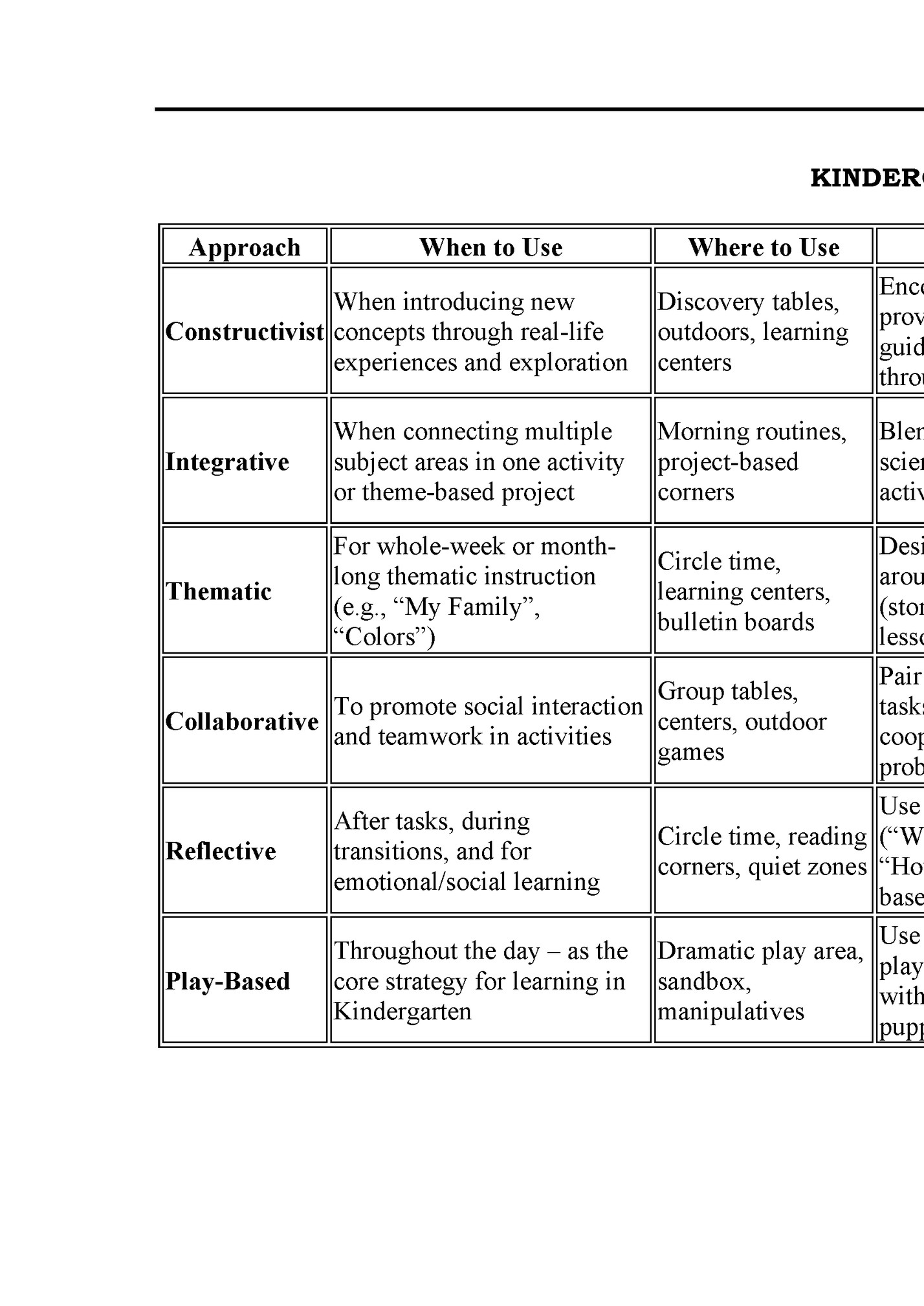
Approach Cooperative Learning Discovery Learning When to Use When developing speaking, writing, reading comprehension, or values integration; during group activities When teaching new grammar rules, vocabulary, or idioms through exploration Hierarchical Learning When teaching concepts that build on each other (e.g., mula sa ponema hanggang sa teksto) Interactive/ Integrated When teaching literature, culture, values, and communication simultaneously Where to Use Group reading stations, oral recitation circles, writing workshops Language labs, vocabulary games, realia-based activities How to Use Form heterogeneous groups; assign clear roles (e.g., leader, reporter); use think-pair-share, jigsaw, or group composition tasks Let students find language patterns through guided tasks (e.g., deducing affixes or rules through sentence analysis) Common Pitfalls Unequal participation, dominant members, or offtask behavior How to Troubleshoot Assign rotating roles, use rubrics, provide task checklists Provide scaffolds like examples, guiding questions, and visual supports Use diagnostic Sequence lessons from simple to Structured grammar Jumping to assessment; ensure complex (e.g., letter-sound lessons, writing advanced topics mastery at each level recognition → syllables → words workshops too soon before moving to the → sentences) next Integrate listening, speaking, Focus integration Role-play areas, reading, and writing in one task Overloaded lesson around a core reading corners, (e.g., dramatizing a story with with too many competency; balance performance tasks dialogue writing and vocabulary objectives activities practice) Learners may struggle without clear direction

Approach Integration LearnerCenteredness When to Use - When connecting English to other subjects or real-life themes- For thematic or project-based learning - When promoting active participation, learner voice, and choiceDuring inquiry-based or discussion activities Where to Use How to Use Integrate reading/writing Thematic units, with subjects like Science or cross-curricular Social Studies; use stories, tasks, performancedebates, or reports tied to based outputs other content areas Use differentiated tasks, Workshops, peer allow choice in topics or feedback groups, reading texts, promote reflection tasks student-led discussions and projects Local literature - When relating lessons discussions, Contextualization to students’ local culture, personal essay community, and daily life writing, oral tasks Constructivist - When encouraging learners to discover, infer, and build knowledge from experience Discovery grammar activities, vocabulary games, peer collaboration Use local texts, culturally relevant topics, or community issues in reading and writing tasks Common Pitfalls How to Troubleshoot Overloaded objectives; lack of cohesion Focus on one central theme or objective; coordinate with other subject teachers May lead to offtask behavior; hard to manage time Set clear expectations; use time frames and goalsetting tools; guide reflection Cultural stereotyping; shallow connections Use authentic and diverse materials; allow learners to share their own experiences and build from them Allow students to observe Lack of structure patterns (e.g., in grammar or direction; usage), make predictions, and slower pacing reflect on their understanding Use scaffolds (sentence frames, prompts), guide reflection, debrief with teacher clarification
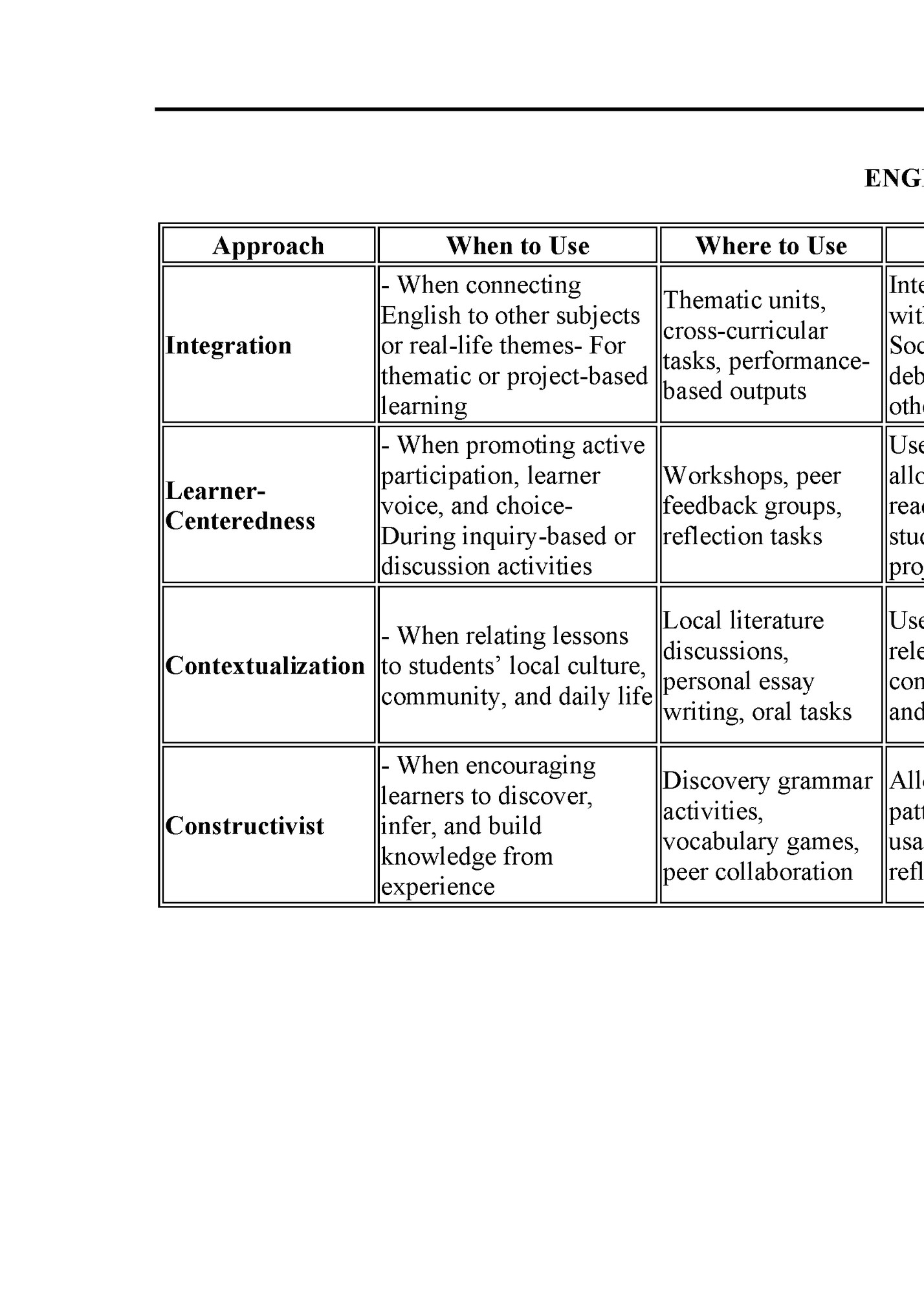
Approach When to Use - When introducing new texts to the whole classShared Reading For modeling reading fluency and comprehension - For targeted support based on reading levelGuided Reading During small group instruction - When teaching decoding skills or building sight word recognition- For early readers or struggling readers Where to Use Whole-class reading corner, projector screen, big books Small reading groups, literacy stations Literacy games, Phonics & phonics Vocabulary stations, flashcard drills Reading - When developing critical journals, Comprehension reading skills- During paired reading, Strategies reading response or book post-reading discussions tasks - When exposing learners Carpet time, to rich texts beyond their Interactive story circles, independent level- For Read-Aloud large text modeling expression and displays vocabulary How to Use Common Pitfalls How to Troubleshoot Teacher reads aloud with class participation; use pointer or highlight text; stop for discussion or questions Passive participation; some learners not engaged Use choral reading, prediction pauses, and think-alouds to involve all learners Group students by reading ability; use leveled texts; prompt comprehension and decoding with questions and support Conduct regular running Wrong group records; allow peer talk; placement; adjust groupings teacher-dominated frequently based on instruction progress Teach sound-letter relationships; Overreliance on use word families, rhymes, and drill; disconnected root words; integrate vocabulary from meaning into context Combine with reading sentences and stories; provide meaningful word use examples Teach skills like predicting, questioning, summarizing; model through think-alouds and allow practice in discussions and reflections Teaching strategies in isolation without applying them Embed strategies in real reading tasks; revisit same strategy across different texts Read aloud expressively; ask questions before/during/after reading; encourage reactions and predictions Use open-ended prompts, Too much teacher let students turn and talk, talk; limited and react to student characters/events in the engagement story
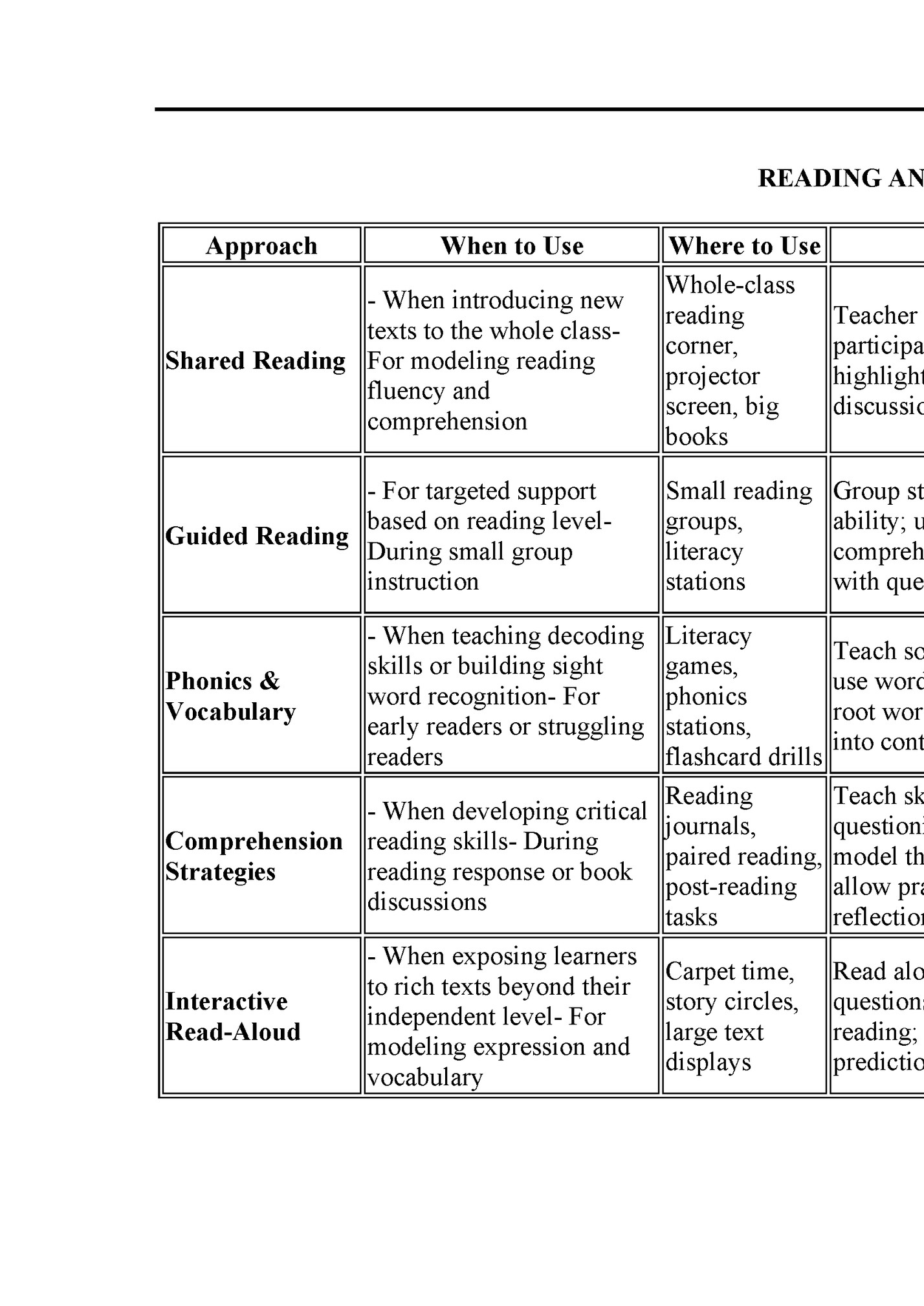
Approach When to Use Where to Use How to Use Use songs, chants, - When developing rhymes, role-play, Oral Proficiency in L1 speaking and listening Play corners, peer- storytelling, and naming through Play, skills- For early sharing time, games; encourage Socialization, and childhood and primary classroom routines conversations in L1; Phonemic Awareness learners- During highlight beginning informal learning time sounds and rhymes - When building Use picture-word walls, Organized Discourses subject-specific Content-integrated concept maps, academic and Verbal language fluencylessons (e.g., vocabulary in L1; design Performances (with During report Science, Araling verbal tasks like vocabulary and presentations, Panlipunan), oral storytelling, show-andacademic terms in L1 dialogues, and oral recitation areas tell, role-playing content across content areas) tasks concepts Common Pitfalls How to Troubleshoot Overemphasis on informal talk without structureLimited vocabulary exposure Combine play with intentional language modeling; introduce new words during play; use picture-word connections Too advanced for learner level; low engagement in academic vocabulary Scaffold discourse using sentence frames; use real objects, visuals, and repeated modeling across lessons
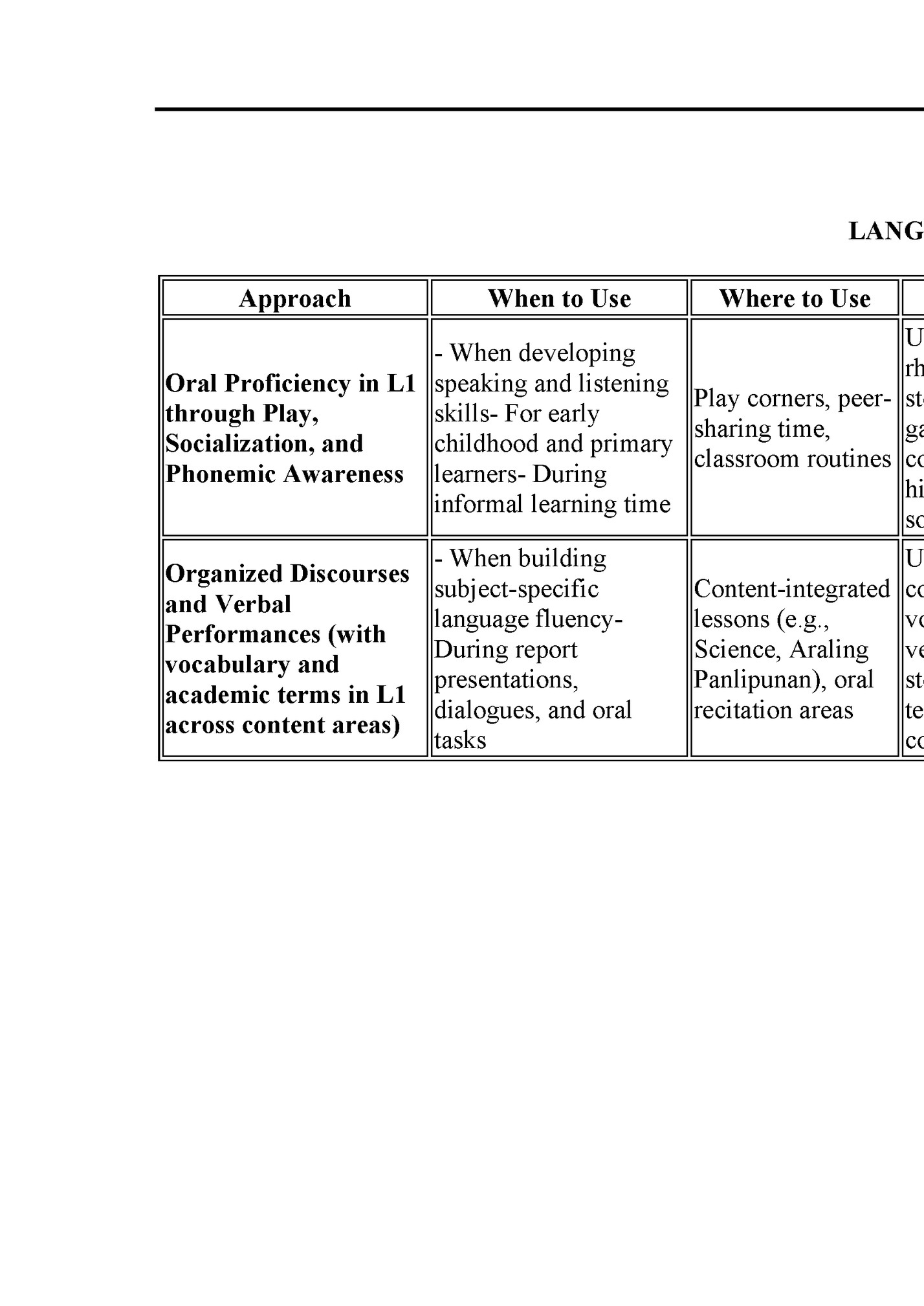
Strategy Ethical Decision Making Social & Emotional Learning (SEL) When to Use When discussing dilemmas, moral questions, or social issues When teaching empathy, selfawareness, responsible decision-making, and relationship skills Where to Use Values classes, story analysis, social studies integration How to Use Common Pitfalls Present real-life situations or fictional conflicts; use Superficial answers decision-making frameworks or binary thinking ("What if...?") Circle time, class meetings, group work feedback sessions Use storytelling, emotion cards, reflection journals, cooperative games Homeroom When helping students sessions, goalCareer Guidance understand their future setting workshops, paths and life choices personal reflections When focusing on Literature-based developing good Virtue Ethics discussions, character traits (e.g., Theory reflection essays, kindness, creative projects responsibility, courage) Debates, issueWhen evaluating moral based essays, Value Ethics behavior based on community Theory values and societal involvement norms activities When promoting active Group activities, engagement, Interactive role-playing, peer collaboration, and peer interviews learning Students may be uncomfortable or unable to express feelings How to Troubleshoot Guide reflection with probing questions; use rubrics for reasoning depth Create a safe classroom climate; offer structured choices for expressing feelings Use interest inventories, life May feel too abstract maps, goal charts, and invite or irrelevant at professionals to share younger ages experiences Use age-appropriate examples; link lessons to real-life experiences and family roles Highlight virtues in texts and Overemphasis on real-life examples; ask preaching or students to identify or model moralizing virtuous actions Focus on student reflection and personal stories; link virtues to daily classroom behavior Engage students in evaluating choices and outcomes; discuss fairness, justice, and common good Clarify the distinction between subjective views and shared values; use case studies Students may confuse personal preference with ethical principles Set clear expectations; Use dialogues, role-plays, May become noisy or assign roles and rotate dramatizations, peer teaching unfocused them; always debrief after activities
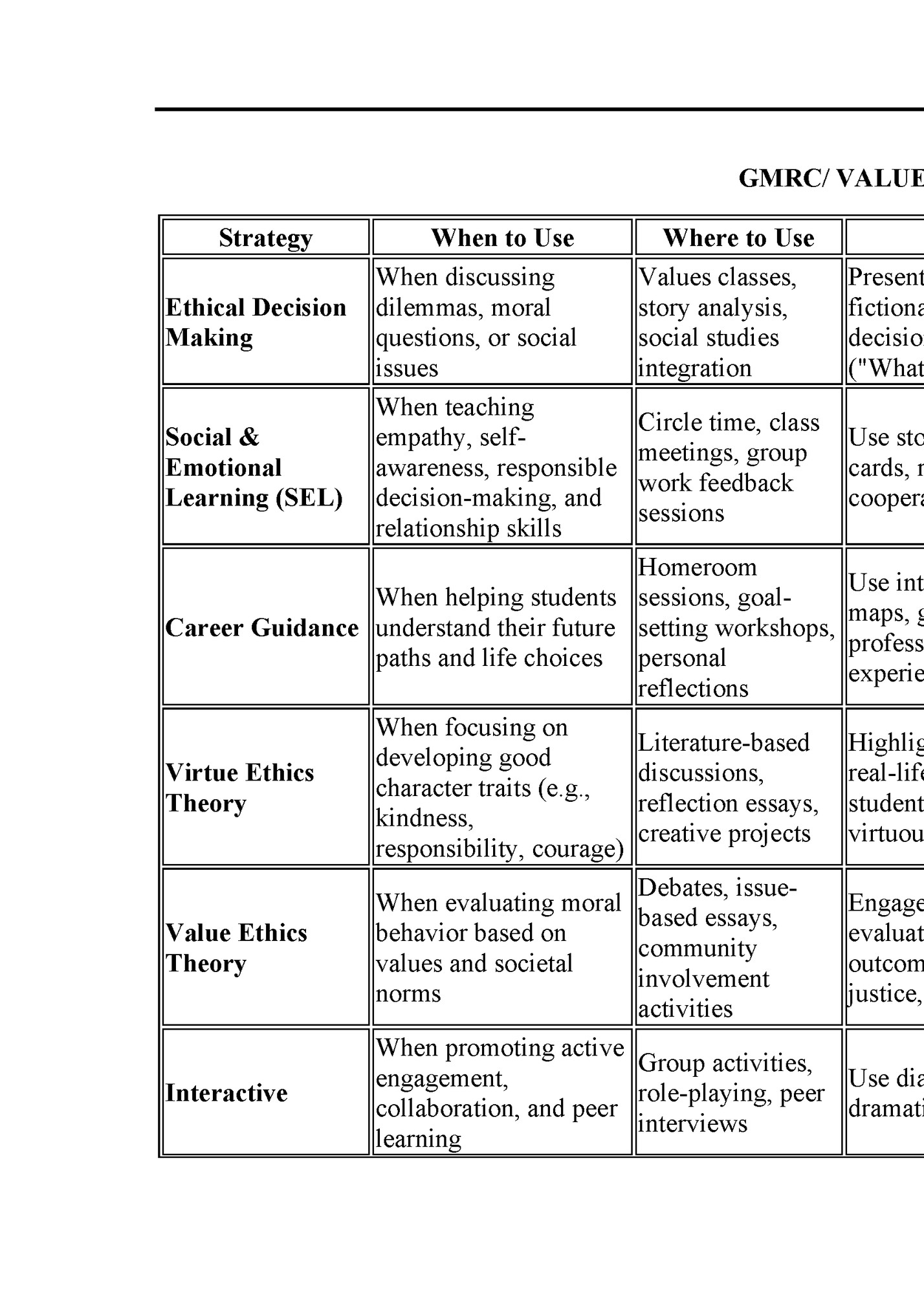
Experiential Constructivism Career Development Theory When to Use When learning is enhanced by doing or experiencing rather than just reading or listening Where to Use Community walks, journaling about personal experiences Project-based When learners build learning, selfunderstanding through directed tasks, their own experiences values inquiry and reflections units How to Use Common Pitfalls Use simulations, real-life Focus may shift from problem-solving tasks, reflection to service learning, and valuesentertainment based games How to Troubleshoot Require reflection or journal entries; connect experiences to target values Intervene with guiding Let learners explore and questions; consolidate question; use group projects Misconceptions may understanding through to discover meaning in go unchecked group sharing and teacher values clarification Help students explore how GuidanceBecomes futureInclude short-term goals When helping students their interests, values, and integrated lessons, focused without and values-based action align their values with strengths influence career life-planning connection to present plans that relate to career and life choices paths; write personal mission sessions behavior current situations or vision statements
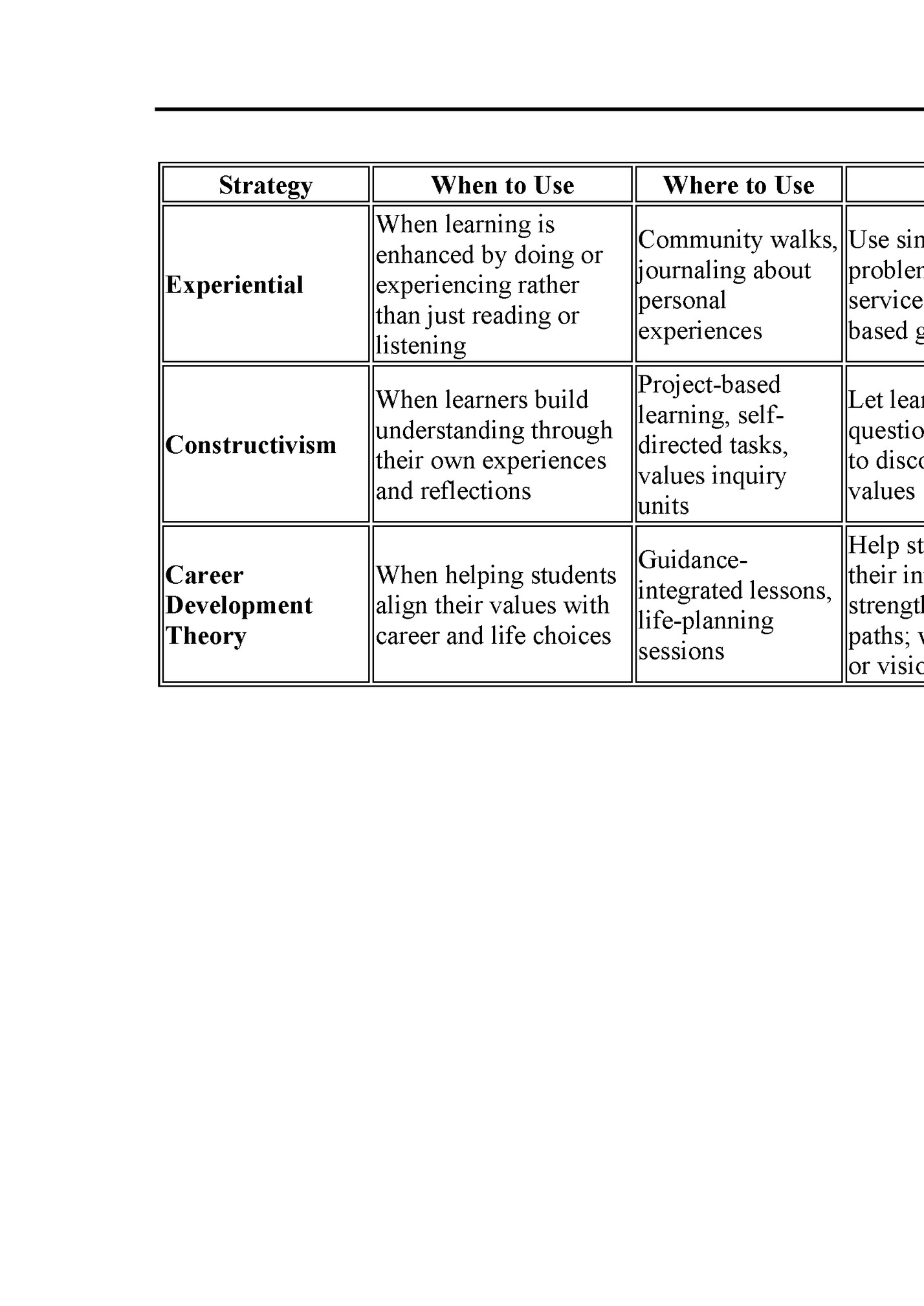
Strategy Discovery & Inquiry-based Learning Experiential & Situated Learning Reflective Learning Cooperative Learning Constructivism When to Use Where to Use How to Use Present real-world problems When introducing new Hands-on activities, or manipulatives; guide concepts or exploring math students to ask questions, patterns and investigations, identify patterns, and build relationships exploratory tasks generalizations Use tasks like measuring When applying math in Outside-theclassroom items, planning real-life contexts (e.g., classroom tasks, an event, or calculating budgeting, measuring, role-play, STEM change; embed math in data collection) activities meaningful situations After problem-solving Ask learners to write or talk Math journals, tasks or assessments; to about how they solved a post-activity build metacognitive and problem, what worked, what reflections, smallconceptual confused them, and what group feedback understanding they’d do differently Use pair or group problemWhen working on solving; assign roles (e.g., problem-solving, math Small group tasks, calculator, checker, games, or investigations peer tutoring, math presenter); include math requiring multiple steps stations games that promote or strategies collaboration When helping students Use manipulatives (blocks, build understanding Concept-building number lines, tiles); connect through prior lessons, math talks, concepts to real-life knowledge, hands-on learning centers experience; build from tools, and personal concrete to abstract reasoning Common Pitfalls How to Troubleshoot Provide scaffolds Students may get (tables, diagrams, clues); confused or reach ask guiding questions; incorrect conclusions debrief with direct instruction Set clear math Tasks may feel objectives; provide stepunstructured or off- by-step expectations; target link experience to math concept explicitly Learners may struggle to express ideas clearly; becomes repetitive Offer sentence stems or prompts (e.g., “I realized that…”); model math reflection routines Rotate roles regularly; Some learners use rubrics or team dominate; others stay checklists; monitor and passive facilitate equal participation Misconceptions can develop if not corrected Allow sharing of multiple strategies; clarify concepts through teacher questioning and structured discussions
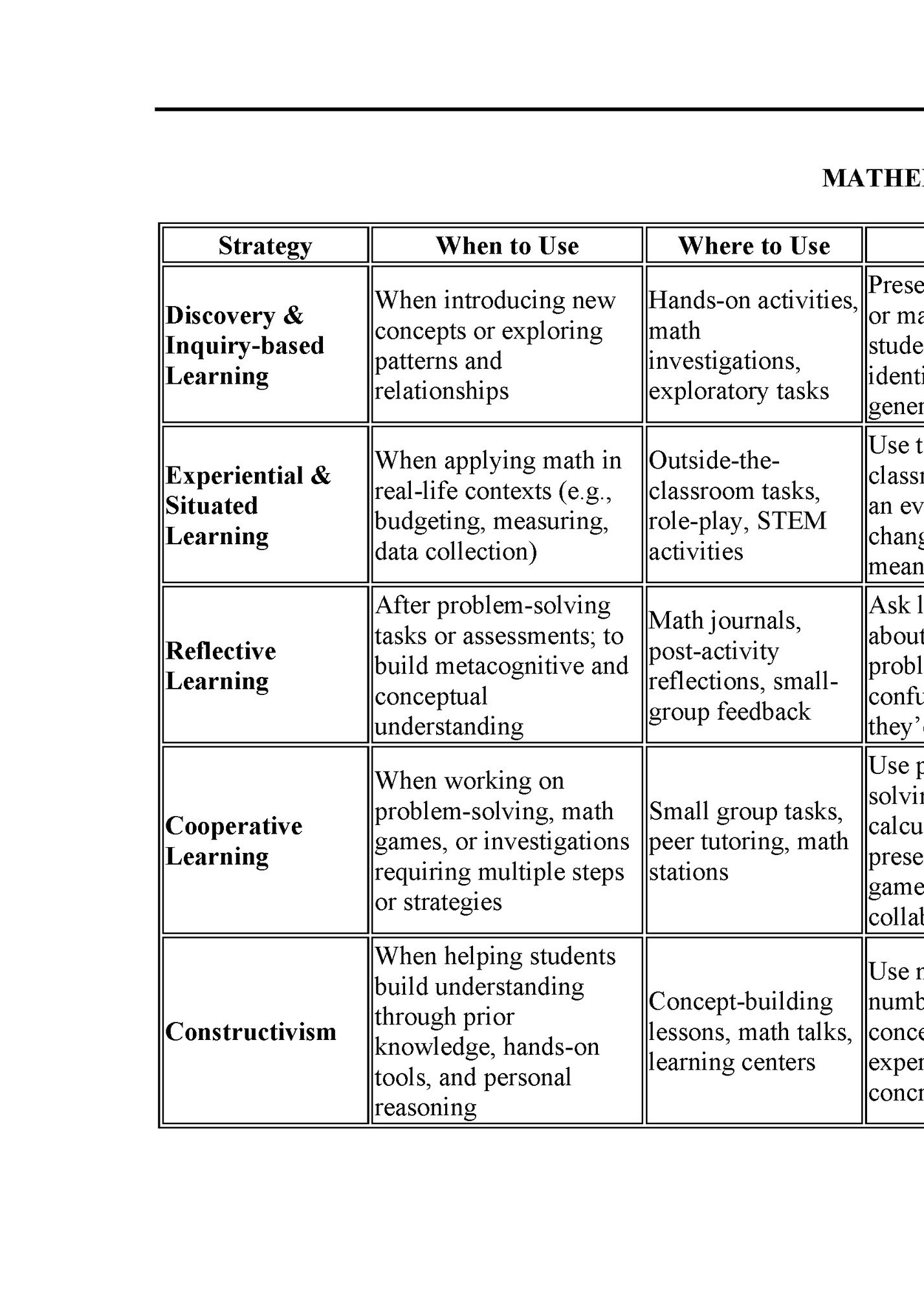
Strategy When to Use Where to Use ThematicChronological Approach When teaching historical content that needs both thematic focus and chronological accuracy History timelines, unit-based instruction, project work Integrative Approach When connecting history, economics, civics, geography, and culture to deepen understanding Civics tasks, cross-topic projects, issuebased discussions Conceptual Approach When focusing on enduring ideas (e.g., power, freedom, interdependence) that go beyond facts and events Concept maps, debates, thematic essays Research-Based Approach When developing analytical, inquiry, and evidence-based thinking skills Investigative reports, historical case studies, local studies When blending Araling Interdisciplinary & Panlipunan with other Multidisciplinary subjects (e.g., Art, Science, Language, Math) Project-based learning, heritage studies, economic simulations How to Use Organize lessons around big themes (e.g., "struggle for freedom") and sequence events over time; use timelines, maps, and cause-effect chains Design lessons that incorporate multiple content strands (e.g., geography + economy); use real-world scenarios and simulations Highlight and revisit key concepts across lessons; guide students to connect specific content to broader social ideas Allow students to ask questions, gather sources (texts, interviews, artifacts), analyze data, and present findings Design thematic units (e.g., climate change from historical, economic, and scientific lenses); involve outputs like posters, reports, campaigns Common Pitfalls How to Troubleshoot Anchor lessons with Learners may visual timelines; use confuse sequence or guiding questions that themes connect events to central themes Overloading learners with too many strands or tasks Focus integration on essential questions or competencies; limit to 2–3 strands per activity Learners may focus on memorization rather than understanding concepts Use big questions and visuals (e.g., concept webs); model conceptual thinking with everyday examples Teach source validation, Copy-paste output; guide question weak research formulation; scaffold questions or lack of research steps with source evaluation rubrics and checklists Difficult collaboration between subject areas; loss of AP focus Coordinate planning; align assessment rubrics; always tie back to AP content and inquiry
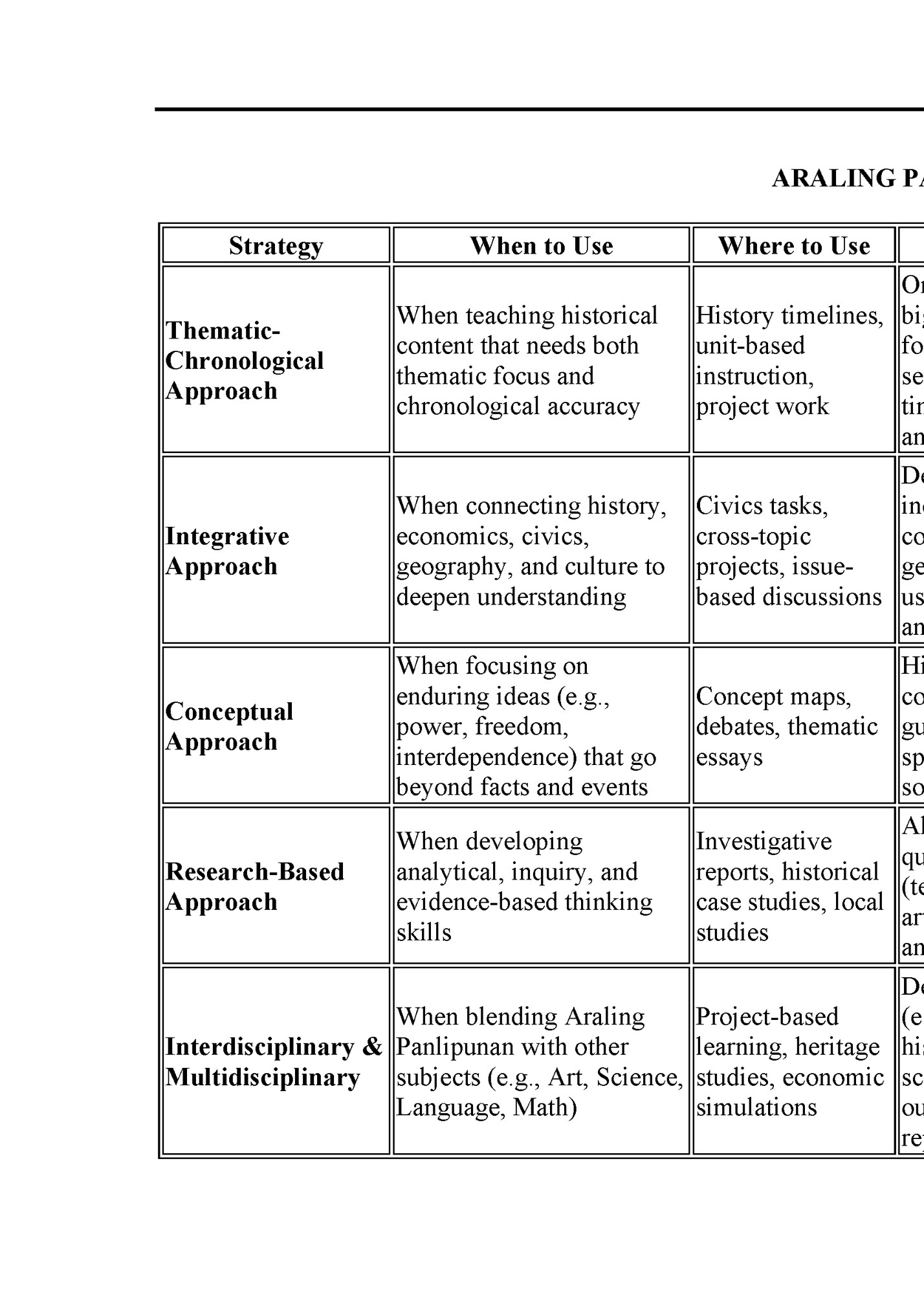
Fleepit Digital © 2021